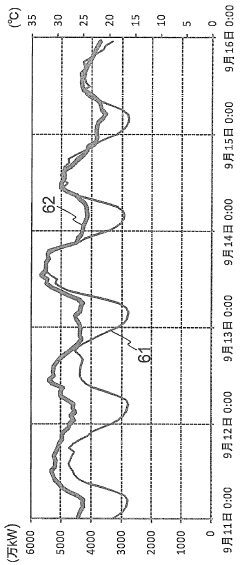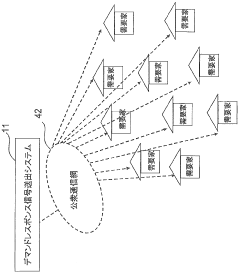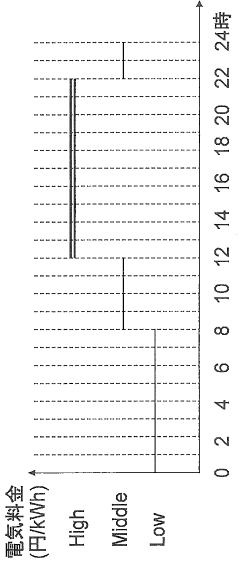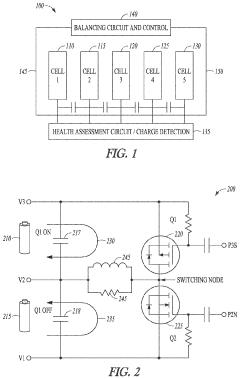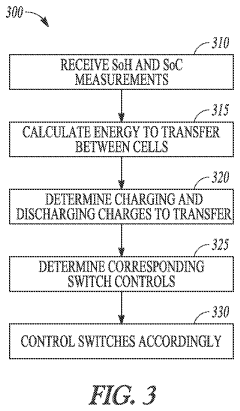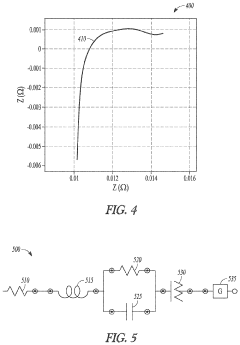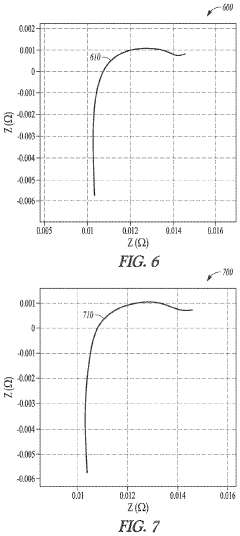Energy Load Balancing with Battery Management Systems in Varying Demand Scenarios
AUG 8, 20259 MIN READ
Generate Your Research Report Instantly with AI Agent
Patsnap Eureka helps you evaluate technical feasibility & market potential.
Energy Load Balancing Background and Objectives
Energy load balancing has become a critical challenge in modern power systems due to the increasing integration of renewable energy sources and the growing demand for electricity. The background of this technology spans several decades, with its roots in traditional power grid management. However, the advent of smart grids and the proliferation of distributed energy resources have significantly transformed the landscape of energy load balancing.
The evolution of energy load balancing technology has been driven by the need to maintain grid stability, improve energy efficiency, and accommodate the intermittent nature of renewable energy sources. Over time, the focus has shifted from simple load shedding techniques to more sophisticated approaches that leverage advanced forecasting, real-time monitoring, and automated control systems.
Battery Management Systems (BMS) have emerged as a key component in addressing the challenges of energy load balancing. These systems have evolved from basic charge controllers to complex, intelligent systems capable of optimizing battery performance, extending battery life, and facilitating seamless integration with the power grid. The development of BMS technology has been closely tied to advancements in battery chemistry, power electronics, and control algorithms.
The primary objective of energy load balancing with BMS in varying demand scenarios is to achieve a harmonious balance between energy supply and demand while maximizing the utilization of available resources. This involves several key goals: enhancing grid stability and reliability, reducing peak demand and associated costs, improving the integration of renewable energy sources, and extending the lifespan of energy storage systems.
Another crucial objective is to develop adaptive and predictive load balancing strategies that can effectively respond to dynamic changes in energy demand and supply. This includes the ability to forecast short-term and long-term load variations, anticipate potential grid disturbances, and proactively adjust energy distribution to maintain optimal system performance.
Furthermore, the technology aims to enable more efficient use of energy storage systems, particularly in scenarios with high variability in demand. By intelligently managing the charging and discharging cycles of batteries, BMS can help smooth out load fluctuations, reduce strain on the grid during peak hours, and maximize the utilization of renewable energy sources when they are available.
As the energy landscape continues to evolve, the objectives of this technology also include facilitating the transition towards a more decentralized and resilient power grid. This involves enabling peer-to-peer energy trading, supporting the development of microgrids, and enhancing the overall flexibility and responsiveness of the energy system to accommodate future technological advancements and changing consumer behaviors.
The evolution of energy load balancing technology has been driven by the need to maintain grid stability, improve energy efficiency, and accommodate the intermittent nature of renewable energy sources. Over time, the focus has shifted from simple load shedding techniques to more sophisticated approaches that leverage advanced forecasting, real-time monitoring, and automated control systems.
Battery Management Systems (BMS) have emerged as a key component in addressing the challenges of energy load balancing. These systems have evolved from basic charge controllers to complex, intelligent systems capable of optimizing battery performance, extending battery life, and facilitating seamless integration with the power grid. The development of BMS technology has been closely tied to advancements in battery chemistry, power electronics, and control algorithms.
The primary objective of energy load balancing with BMS in varying demand scenarios is to achieve a harmonious balance between energy supply and demand while maximizing the utilization of available resources. This involves several key goals: enhancing grid stability and reliability, reducing peak demand and associated costs, improving the integration of renewable energy sources, and extending the lifespan of energy storage systems.
Another crucial objective is to develop adaptive and predictive load balancing strategies that can effectively respond to dynamic changes in energy demand and supply. This includes the ability to forecast short-term and long-term load variations, anticipate potential grid disturbances, and proactively adjust energy distribution to maintain optimal system performance.
Furthermore, the technology aims to enable more efficient use of energy storage systems, particularly in scenarios with high variability in demand. By intelligently managing the charging and discharging cycles of batteries, BMS can help smooth out load fluctuations, reduce strain on the grid during peak hours, and maximize the utilization of renewable energy sources when they are available.
As the energy landscape continues to evolve, the objectives of this technology also include facilitating the transition towards a more decentralized and resilient power grid. This involves enabling peer-to-peer energy trading, supporting the development of microgrids, and enhancing the overall flexibility and responsiveness of the energy system to accommodate future technological advancements and changing consumer behaviors.
Market Analysis for Smart Grid Solutions
The smart grid solutions market is experiencing significant growth, driven by the increasing demand for efficient energy management systems and the global push towards renewable energy integration. As utilities and energy providers seek to modernize their infrastructure, the market for smart grid technologies, including energy load balancing and battery management systems, is expanding rapidly.
Current market trends indicate a strong focus on demand response programs and advanced metering infrastructure (AMI) to better manage varying energy demand scenarios. These solutions enable utilities to optimize energy distribution, reduce peak loads, and improve overall grid stability. The integration of battery storage systems with smart grid technologies is becoming increasingly crucial in addressing the intermittency issues associated with renewable energy sources.
Market research suggests that the global smart grid market is expected to grow substantially over the next decade. This growth is attributed to factors such as government initiatives promoting smart grid adoption, increasing investments in grid modernization projects, and the rising need for reliable and efficient power distribution systems. The Asia-Pacific region is anticipated to witness the highest growth rate, driven by rapid urbanization and industrialization in countries like China and India.
Key market segments within the smart grid solutions sector include advanced metering infrastructure, distribution management systems, substation automation, and grid analytics. Among these, energy load balancing and battery management systems are gaining traction as critical components for managing varying demand scenarios and integrating renewable energy sources.
The competitive landscape of the smart grid solutions market is characterized by a mix of established players and innovative startups. Major companies are investing heavily in research and development to enhance their product offerings and maintain their market position. Partnerships and collaborations between technology providers, utilities, and energy storage companies are becoming more common, fostering innovation and accelerating market growth.
Customer adoption of smart grid solutions is influenced by factors such as energy cost savings, improved reliability, and environmental concerns. Utilities are increasingly recognizing the value of these technologies in reducing operational costs, improving customer satisfaction, and meeting regulatory requirements for grid modernization and carbon emission reduction.
Despite the positive outlook, the market faces challenges such as high initial implementation costs, cybersecurity concerns, and the need for standardization across different smart grid technologies. Addressing these issues will be crucial for widespread adoption and long-term market growth.
Current market trends indicate a strong focus on demand response programs and advanced metering infrastructure (AMI) to better manage varying energy demand scenarios. These solutions enable utilities to optimize energy distribution, reduce peak loads, and improve overall grid stability. The integration of battery storage systems with smart grid technologies is becoming increasingly crucial in addressing the intermittency issues associated with renewable energy sources.
Market research suggests that the global smart grid market is expected to grow substantially over the next decade. This growth is attributed to factors such as government initiatives promoting smart grid adoption, increasing investments in grid modernization projects, and the rising need for reliable and efficient power distribution systems. The Asia-Pacific region is anticipated to witness the highest growth rate, driven by rapid urbanization and industrialization in countries like China and India.
Key market segments within the smart grid solutions sector include advanced metering infrastructure, distribution management systems, substation automation, and grid analytics. Among these, energy load balancing and battery management systems are gaining traction as critical components for managing varying demand scenarios and integrating renewable energy sources.
The competitive landscape of the smart grid solutions market is characterized by a mix of established players and innovative startups. Major companies are investing heavily in research and development to enhance their product offerings and maintain their market position. Partnerships and collaborations between technology providers, utilities, and energy storage companies are becoming more common, fostering innovation and accelerating market growth.
Customer adoption of smart grid solutions is influenced by factors such as energy cost savings, improved reliability, and environmental concerns. Utilities are increasingly recognizing the value of these technologies in reducing operational costs, improving customer satisfaction, and meeting regulatory requirements for grid modernization and carbon emission reduction.
Despite the positive outlook, the market faces challenges such as high initial implementation costs, cybersecurity concerns, and the need for standardization across different smart grid technologies. Addressing these issues will be crucial for widespread adoption and long-term market growth.
Current Challenges in Battery Management Systems
Battery Management Systems (BMS) face several significant challenges in the context of energy load balancing under varying demand scenarios. One of the primary issues is the accurate prediction of energy demand fluctuations. As renewable energy sources become more prevalent, the intermittent nature of solar and wind power introduces unpredictability into the grid. BMS must adapt to these rapid changes in supply and demand, which requires sophisticated forecasting algorithms and real-time data processing capabilities.
Another challenge lies in the optimization of battery charging and discharging cycles. Frequent and deep cycling of batteries can lead to accelerated degradation, reducing their lifespan and efficiency. BMS need to balance the immediate need for energy with the long-term health of the battery systems. This involves complex decision-making processes that consider factors such as state of charge, depth of discharge, temperature, and historical usage patterns.
The thermal management of large-scale battery systems presents a significant hurdle. As batteries charge and discharge, they generate heat, which can impact their performance and safety. In scenarios of high demand or rapid cycling, the heat generation can be substantial. BMS must effectively monitor and regulate temperature across the entire battery array, often in diverse environmental conditions, to prevent thermal runaway and ensure optimal performance.
Scalability and integration pose additional challenges for BMS. As energy grids incorporate larger and more diverse battery storage solutions, BMS must be able to manage increasingly complex systems. This includes coordinating multiple battery types, integrating with various renewable energy sources, and interfacing with smart grid technologies. The ability to scale efficiently while maintaining system stability and performance is crucial.
Data management and communication represent another critical area of concern. BMS generate vast amounts of data that must be collected, analyzed, and acted upon in real-time. Ensuring secure, reliable, and low-latency communication between battery systems, energy management systems, and grid operators is essential for effective load balancing. This requires robust networking infrastructure and advanced data analytics capabilities.
Lastly, the regulatory and economic landscape presents challenges for BMS implementation. Varying energy market structures, grid codes, and regulatory requirements across different regions can complicate the deployment of standardized BMS solutions. Additionally, the economic viability of energy storage systems depends on factors such as electricity pricing, demand charges, and incentive programs, which can vary significantly and impact the optimal operation strategies for BMS.
Another challenge lies in the optimization of battery charging and discharging cycles. Frequent and deep cycling of batteries can lead to accelerated degradation, reducing their lifespan and efficiency. BMS need to balance the immediate need for energy with the long-term health of the battery systems. This involves complex decision-making processes that consider factors such as state of charge, depth of discharge, temperature, and historical usage patterns.
The thermal management of large-scale battery systems presents a significant hurdle. As batteries charge and discharge, they generate heat, which can impact their performance and safety. In scenarios of high demand or rapid cycling, the heat generation can be substantial. BMS must effectively monitor and regulate temperature across the entire battery array, often in diverse environmental conditions, to prevent thermal runaway and ensure optimal performance.
Scalability and integration pose additional challenges for BMS. As energy grids incorporate larger and more diverse battery storage solutions, BMS must be able to manage increasingly complex systems. This includes coordinating multiple battery types, integrating with various renewable energy sources, and interfacing with smart grid technologies. The ability to scale efficiently while maintaining system stability and performance is crucial.
Data management and communication represent another critical area of concern. BMS generate vast amounts of data that must be collected, analyzed, and acted upon in real-time. Ensuring secure, reliable, and low-latency communication between battery systems, energy management systems, and grid operators is essential for effective load balancing. This requires robust networking infrastructure and advanced data analytics capabilities.
Lastly, the regulatory and economic landscape presents challenges for BMS implementation. Varying energy market structures, grid codes, and regulatory requirements across different regions can complicate the deployment of standardized BMS solutions. Additionally, the economic viability of energy storage systems depends on factors such as electricity pricing, demand charges, and incentive programs, which can vary significantly and impact the optimal operation strategies for BMS.
Existing Load Balancing and BMS Solutions
01 Load balancing techniques in battery management systems
Battery management systems employ various load balancing techniques to optimize the performance and lifespan of battery cells. These techniques involve distributing the load evenly across multiple cells, preventing overcharging or undercharging of individual cells, and ensuring efficient energy utilization. Advanced algorithms and control mechanisms are used to monitor and adjust the load distribution in real-time, enhancing overall system efficiency and reliability.- Load balancing in distributed battery management systems: This approach involves distributing the load across multiple battery cells or modules in a battery management system. It ensures optimal utilization of the battery capacity, prevents overloading of individual cells, and extends the overall lifespan of the battery system. The load balancing algorithms take into account factors such as state of charge, temperature, and capacity of each cell to make intelligent decisions on load distribution.
- Adaptive load balancing techniques for battery systems: Adaptive load balancing techniques dynamically adjust the load distribution based on real-time conditions and performance metrics of the battery system. These methods use machine learning algorithms and predictive models to optimize load balancing, improving efficiency and reliability of the battery management system. The adaptive approach allows for better handling of varying load conditions and battery degradation over time.
- Thermal management in battery load balancing: This aspect focuses on integrating thermal management considerations into the load balancing strategy of battery management systems. It involves monitoring and controlling the temperature of individual cells and modules while balancing the load. The approach helps prevent thermal runaway, ensures uniform temperature distribution, and maintains optimal operating conditions for the battery system, thereby enhancing safety and performance.
- Communication protocols for coordinated load balancing: This point emphasizes the importance of efficient communication protocols in coordinating load balancing across distributed battery management systems. It involves developing and implementing standardized communication interfaces and data exchange formats to enable seamless interaction between different components of the battery system. These protocols facilitate real-time data sharing, synchronization, and coordinated decision-making for effective load balancing.
- Energy storage system integration with load balancing: This approach focuses on integrating battery management systems with broader energy storage systems and grid infrastructure. It involves developing load balancing strategies that consider not only the battery system but also the overall energy ecosystem. This integration enables more efficient energy management, supports grid stability, and optimizes the utilization of renewable energy sources in conjunction with battery storage.
02 Communication protocols for battery management systems
Effective communication protocols are crucial for battery management systems to facilitate seamless data exchange between various components. These protocols enable real-time monitoring of battery status, load distribution, and system performance. They support rapid decision-making and control actions, ensuring optimal load balancing and system operation. Advanced communication technologies are implemented to enhance data transfer speed and reliability within the battery management network.Expand Specific Solutions03 Adaptive control strategies for load balancing
Battery management systems incorporate adaptive control strategies to dynamically adjust load balancing based on changing conditions. These strategies use machine learning algorithms and predictive models to anticipate load variations and optimize battery performance. The system continuously learns from historical data and current operating conditions to refine its load balancing decisions, improving energy efficiency and extending battery life.Expand Specific Solutions04 Thermal management in battery load balancing
Thermal management plays a crucial role in battery load balancing systems. Advanced thermal control techniques are employed to maintain optimal operating temperatures across battery cells during load balancing operations. This involves the use of cooling systems, heat dissipation mechanisms, and temperature monitoring sensors to prevent thermal runaway and ensure safe and efficient battery operation under varying load conditions.Expand Specific Solutions05 Integration of renewable energy sources in battery management systems
Modern battery management systems are designed to integrate renewable energy sources for enhanced load balancing capabilities. These systems incorporate smart algorithms to manage the intermittent nature of renewable sources like solar and wind, optimizing energy storage and distribution. The integration allows for more efficient use of renewable energy, reduces reliance on grid power, and improves overall system sustainability and reliability.Expand Specific Solutions
Key Players in Energy Storage and Grid Management
The energy load balancing market with battery management systems is in a growth phase, driven by increasing demand for renewable energy integration and grid stability. The market size is expanding rapidly, with projections indicating significant growth in the coming years. Technologically, the field is advancing quickly, with major players like LG Energy Solution, Samsung SDI, and Contemporary Amperex Technology leading innovation. These companies are developing sophisticated battery management systems to optimize energy storage and distribution. Other key players such as Bosch, NEC, and Kyocera are contributing to the technological maturity by integrating advanced control algorithms and IoT capabilities. The competitive landscape is diverse, with both established electronics giants and specialized energy storage firms vying for market share.
LG Energy Solution Ltd.
Technical Solution: LG Energy Solution has developed an advanced Battery Management System (BMS) for energy load balancing in varying demand scenarios. Their system utilizes AI-driven predictive algorithms to optimize battery performance and longevity. The BMS employs real-time monitoring of individual cell voltages, temperatures, and state of charge to ensure balanced energy distribution[1]. It incorporates adaptive charging and discharging strategies based on usage patterns and environmental conditions. The system also features a cloud-connected platform for remote diagnostics and over-the-air updates, allowing for continuous improvement of load balancing algorithms[3]. LG's BMS includes a sophisticated thermal management system that maintains optimal operating temperatures, crucial for consistent performance across diverse demand scenarios[5].
Strengths: Advanced AI algorithms for predictive load balancing, comprehensive cell-level monitoring, and cloud connectivity for remote management. Weaknesses: Potential complexity in implementation and higher initial costs compared to simpler systems.
Samsung SDI Co., Ltd.
Technical Solution: Samsung SDI has engineered a cutting-edge Battery Management System focused on energy load balancing for varying demand scenarios. Their solution incorporates machine learning algorithms that adapt to changing usage patterns and environmental factors. The system utilizes high-precision sensors for real-time monitoring of battery parameters, including voltage, current, and temperature at the cell level[2]. Samsung's BMS features dynamic power allocation, automatically adjusting energy distribution based on demand forecasts and grid conditions. It also includes an innovative cell balancing technique that extends battery life by equalizing the state of charge across all cells[4]. The system is designed with modular architecture, allowing for easy scalability and integration with various energy storage applications[6].
Strengths: Adaptive machine learning algorithms, high-precision monitoring, and modular design for scalability. Weaknesses: May require significant computational resources and specialized expertise for optimal configuration and maintenance.
Core Innovations in Battery Management Systems
Energy management system and energy management method
PatentWO2014136353A1
Innovation
- An energy management system that adjusts the charging and discharging of storage batteries based on external power demand signals and outdoor temperature, allowing batteries to be charged during low demand periods and discharged during high demand periods without altering consumer comfort settings, thereby stabilizing power supply and demand.
Adaptive balancing for battery management
PatentActiveUS11820253B2
Innovation
- A smart adaptive balancing system that continuously monitors the state of health and charge of multiple battery cells, using an energy balancing circuit and health assessment circuit to switch energy between cells based on measured parameters, ensuring balanced state of charge through capacitive or inductive charge shuttling, thereby extending battery life and saving energy.
Regulatory Framework for Energy Grid Management
The regulatory framework for energy grid management plays a crucial role in shaping the implementation and operation of energy load balancing systems, including those utilizing battery management systems in varying demand scenarios. Governments and regulatory bodies worldwide have established comprehensive guidelines and standards to ensure the safe, efficient, and reliable operation of energy grids while promoting the integration of renewable energy sources and advanced energy storage technologies.
In many jurisdictions, regulatory frameworks have evolved to accommodate the increasing complexity of modern energy systems. These frameworks typically address key aspects such as grid stability, power quality, energy storage integration, and demand response mechanisms. For instance, the Federal Energy Regulatory Commission (FERC) in the United States has issued orders like Order No. 841, which aims to remove barriers to the participation of electric storage resources in the capacity, energy, and ancillary service markets operated by Regional Transmission Organizations (RTOs) and Independent System Operators (ISOs).
The European Union has also developed a robust regulatory framework for energy grid management, with directives such as the Clean Energy Package setting ambitious targets for renewable energy integration and energy efficiency. These regulations often include provisions for the deployment of smart grid technologies and the use of battery storage systems to enhance grid flexibility and reliability.
Regulatory frameworks typically outline specific requirements for battery management systems used in grid applications. These may include safety standards, performance metrics, and interoperability guidelines. For example, the IEEE 1547 standard in the United States provides technical specifications for the interconnection and interoperability of distributed energy resources with electric power systems.
Furthermore, regulatory bodies often establish market mechanisms to incentivize the adoption of energy storage technologies and load balancing solutions. This may include capacity markets, ancillary service markets, and time-of-use pricing schemes that encourage the deployment of battery systems to address varying demand scenarios.
As the energy landscape continues to evolve, regulatory frameworks are adapting to address emerging challenges and opportunities. This includes the development of regulations for vehicle-to-grid (V2G) technologies, aggregated distributed energy resources, and microgrid operations. These advancements in regulatory frameworks aim to create a more flexible, resilient, and sustainable energy grid capable of effectively managing the complexities of modern energy systems.
In many jurisdictions, regulatory frameworks have evolved to accommodate the increasing complexity of modern energy systems. These frameworks typically address key aspects such as grid stability, power quality, energy storage integration, and demand response mechanisms. For instance, the Federal Energy Regulatory Commission (FERC) in the United States has issued orders like Order No. 841, which aims to remove barriers to the participation of electric storage resources in the capacity, energy, and ancillary service markets operated by Regional Transmission Organizations (RTOs) and Independent System Operators (ISOs).
The European Union has also developed a robust regulatory framework for energy grid management, with directives such as the Clean Energy Package setting ambitious targets for renewable energy integration and energy efficiency. These regulations often include provisions for the deployment of smart grid technologies and the use of battery storage systems to enhance grid flexibility and reliability.
Regulatory frameworks typically outline specific requirements for battery management systems used in grid applications. These may include safety standards, performance metrics, and interoperability guidelines. For example, the IEEE 1547 standard in the United States provides technical specifications for the interconnection and interoperability of distributed energy resources with electric power systems.
Furthermore, regulatory bodies often establish market mechanisms to incentivize the adoption of energy storage technologies and load balancing solutions. This may include capacity markets, ancillary service markets, and time-of-use pricing schemes that encourage the deployment of battery systems to address varying demand scenarios.
As the energy landscape continues to evolve, regulatory frameworks are adapting to address emerging challenges and opportunities. This includes the development of regulations for vehicle-to-grid (V2G) technologies, aggregated distributed energy resources, and microgrid operations. These advancements in regulatory frameworks aim to create a more flexible, resilient, and sustainable energy grid capable of effectively managing the complexities of modern energy systems.
Environmental Impact of Advanced Load Balancing
Advanced load balancing techniques in energy systems, particularly those incorporating battery management systems, have significant environmental implications. These systems optimize energy distribution and consumption, leading to reduced overall energy demand and improved efficiency. By effectively managing peak loads and smoothing out demand fluctuations, advanced load balancing minimizes the need for additional power generation, especially from fossil fuel sources.
The environmental benefits of such systems are multifaceted. Firstly, they contribute to a reduction in greenhouse gas emissions. By reducing reliance on peaker plants, which are often fossil fuel-based and less efficient, these systems help decrease carbon dioxide and other harmful emissions. This impact is particularly pronounced in regions where the energy mix is still heavily dependent on non-renewable sources.
Furthermore, advanced load balancing systems enhance the integration of renewable energy sources into the grid. By managing the intermittent nature of renewables like solar and wind, these systems allow for higher penetration of clean energy sources. This not only reduces the carbon footprint of the energy sector but also promotes the transition towards a more sustainable energy landscape.
The implementation of battery management systems in load balancing also has positive environmental effects related to resource conservation. By optimizing battery usage and extending their lifespan, these systems reduce the frequency of battery replacements. This, in turn, decreases the environmental impact associated with battery production and disposal, including the extraction of raw materials and the management of electronic waste.
Moreover, advanced load balancing contributes to reduced strain on the electrical grid infrastructure. By smoothing out demand peaks, it minimizes the need for grid expansions and upgrades, which often involve significant land use changes and resource consumption. This indirect environmental benefit is often overlooked but can be substantial in terms of preserving natural habitats and reducing the ecological footprint of energy infrastructure.
However, it's important to note that the environmental impact of these systems is not entirely positive. The production of advanced battery systems and sophisticated control technologies involves energy-intensive processes and the use of rare earth elements. These factors can partially offset the environmental gains, especially in the short term. Therefore, a comprehensive life cycle assessment is crucial to fully understand the net environmental impact of implementing advanced load balancing systems with battery management.
The environmental benefits of such systems are multifaceted. Firstly, they contribute to a reduction in greenhouse gas emissions. By reducing reliance on peaker plants, which are often fossil fuel-based and less efficient, these systems help decrease carbon dioxide and other harmful emissions. This impact is particularly pronounced in regions where the energy mix is still heavily dependent on non-renewable sources.
Furthermore, advanced load balancing systems enhance the integration of renewable energy sources into the grid. By managing the intermittent nature of renewables like solar and wind, these systems allow for higher penetration of clean energy sources. This not only reduces the carbon footprint of the energy sector but also promotes the transition towards a more sustainable energy landscape.
The implementation of battery management systems in load balancing also has positive environmental effects related to resource conservation. By optimizing battery usage and extending their lifespan, these systems reduce the frequency of battery replacements. This, in turn, decreases the environmental impact associated with battery production and disposal, including the extraction of raw materials and the management of electronic waste.
Moreover, advanced load balancing contributes to reduced strain on the electrical grid infrastructure. By smoothing out demand peaks, it minimizes the need for grid expansions and upgrades, which often involve significant land use changes and resource consumption. This indirect environmental benefit is often overlooked but can be substantial in terms of preserving natural habitats and reducing the ecological footprint of energy infrastructure.
However, it's important to note that the environmental impact of these systems is not entirely positive. The production of advanced battery systems and sophisticated control technologies involves energy-intensive processes and the use of rare earth elements. These factors can partially offset the environmental gains, especially in the short term. Therefore, a comprehensive life cycle assessment is crucial to fully understand the net environmental impact of implementing advanced load balancing systems with battery management.
Unlock deeper insights with Patsnap Eureka Quick Research — get a full tech report to explore trends and direct your research. Try now!
Generate Your Research Report Instantly with AI Agent
Supercharge your innovation with Patsnap Eureka AI Agent Platform!

